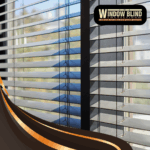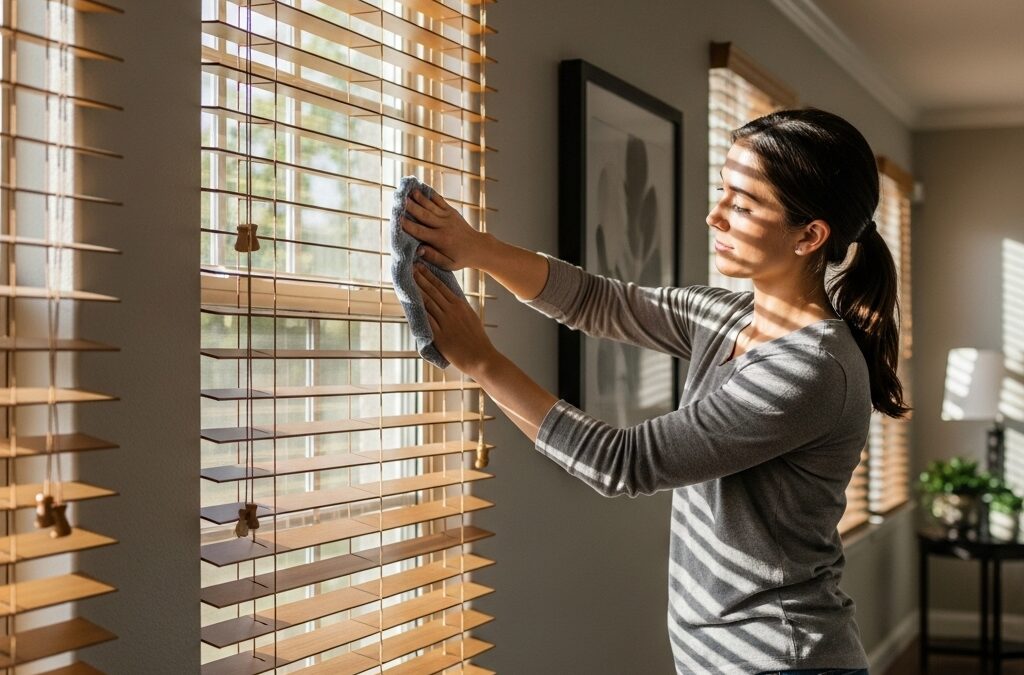
Wood Blinds Replacement Slats in Simi Valley California
November 21, 2025
Redefine Your Space with Aluminum Blinds
November 27, 2025In Simi Valley, light is a daily gift—and, if we are honest, a daily challenge for anyone who wants their home to look crisp and cared for. Our dry air and bright skies mean dust travels quickly and the sun shows everything, from fingerprints on a bottom rail to a faint haze that softens a once-sparkling finish. Wood blinds are a favorite here because they tame glare gracefully while adding a natural warmth that suits ranch, Spanish revival, and contemporary homes alike. Keep them looking their best, and they reward you with rooms that feel calm and finished every day. These cleaning tips are based on real homes along Sycamore, First Street, Cochran, and in neighborhoods like Wood Ranch and the Knolls, where the rhythms of sun, wind, and weekend living shape how blinds age and how they shine after a little attention.
Before anything else, it helps to choose the right tools and a realistic routine. You do not need a cabinet full of cleaners. A soft microfiber cloth, a vacuum with a gentle brush attachment, a feather duster for quick passes, and a slightly damp cloth for occasional spots are usually enough. If you make a habit of light, regular care, your blinds will require less effort when you decide to do a more thorough refresh. Consistency is everything in our climate, and a few minutes once a week can keep dust from setting into the tiny textures of the finish.
The finish on your blinds matters. Painted slats call for slightly different handling than stained ones. Painted wood tends to hide fine dust better but can show smudges around the lift rail or wand area. Stained slats show dust more quickly but also glow beautifully when clean because the grain reflects light with a gentle sheen. Knowing what you have helps you match your approach to your blinds rather than fighting them. If you are not sure whether a spot is on the surface or in the finish, test an inconspicuous area first with a dry wipe, then a barely damp pass, and finally a dry follow-up.
For everyday maintenance, tilt the slats closed in one direction and dust from top to bottom with your microfiber cloth or a feather duster. Then reverse the tilt and repeat. This catches both edges of each slat and prevents streaks. If using a vacuum, set the brush attachment to its softest setting and use light strokes; the goal is to lift dust, not push it around. On windy days—when Santa Ana gusts blow through open windows—you may need an extra pass midweek in high-traffic rooms, particularly near sliders and patio doors where dust rides in on every hello and goodbye.
Grease and kitchen haze require a different tactic. In breakfast nooks and kitchen bays, a faint film can settle over time, especially on the slats closest to the stove or sink. Begin with a dry dust to remove loose particles. Then, with a cloth slightly dampened in lukewarm water, gently wipe each slat, supporting it with your free hand to prevent flexing. Immediately follow with a dry cloth to keep moisture from lingering. Avoid all-purpose sprays; they can leave a dull residue that catches dust faster next time. If you need more help for a stubborn spot, a mild, wood-safe cleaner lightly applied to the cloth—not the blind—can do the trick. Always test first.
Bathroom blinds deserve a quick mention. Our air is generally dry, but showers can fill a room with steam in minutes, and that moisture loves to settle on slats. If you have wood blinds in a primary bath, regular ventilation and a post-shower wipe keeps them looking new. Better yet, consider placing wood blinds away from direct steam zones and using a moisture-resistant alternative right at the tub or shower window. Throughout the rest of the house, wood is a pleasure to live with, and Simi Valley’s dry air keeps day-to-day care straightforward.
Sun is both a friend and a critic. It makes rooms feel alive, but it will also highlight dust that might otherwise go unnoticed. A smart strategy is to dust windows in the late afternoon on west-facing elevations when angled light reveals everything. On north-facing windows, a morning once-over works well. Pay special attention to the bottom rail. It is the landing pad for everything and tends to collect fingerprints from everyday adjustments. A quick, dry buff along that rail transforms the whole window at a glance.
Deep Cleaning Without Overdoing It
Once or twice a year, dedicate a bit more time to a deep clean. Take a close look at cords, ladders, and the headrail. Dust tends to gather at junctions and under the valance. Gently lift the valance if it is removable, and use your vacuum’s brush to coax out the fine debris. Clean the wand or tilt control, which can develop a subtle film over time. As always, keep water to a minimum—wood likes to be clean, not wet. The secret to a deep clean is patience, moving methodically from one side to the other so you do not re-deposit dust where you just wiped.
Protecting the Finish
Preserving the finish is as important as removing dust. Avoid abrasive pads, paper towels, or anything that can scratch. Microfiber is your friend. Do not apply polish or oils unless the manufacturer specifies them; most modern finishes are designed to be low-maintenance and can react unpredictably to conditioning products. If you have a stubborn mark, resist the urge to scrub. Gentle repetition—light wipes over time—does less harm than a single aggressive attempt. In our bright light, scratches can catch the eye, but a cautious touch keeps the surface smooth and reflective.
Working With Slat Position
The way you position slats during cleaning affects how effective your efforts are. A slight upward tilt exposes the underside of each slat to the cloth and lets you see the dust line. When you reverse, a slight downward tilt does the same. Keeping slats fully closed in either direction can compress dust into the V-shaped seam. Instead, open just enough to create a flat surface for your cloth to glide across. Supporting longer slats with your free hand, especially on wide windows, prevents any stress on the cords as you wipe.
Seasonal Schedules That Fit Valley Life
Think about your calendar. Spring brings breezes and open windows, so weekly dusting keeps pollen and road dust from settling. Summer’s dry heat means windows are often closed and air conditioning runs; biweekly care can be enough, with a quick check of west-facing blinds where the sun hits hardest. Fall’s Santa Ana winds call for a touch more attention, especially around entryways. Winter is gentle: a monthly refresh often does the job, with an extra wipe before holiday gatherings when every surface seems to matter a bit more.
Kids, Pets, and Everyday Realities
Homes are for living. Paw prints on a sill or a child’s curious fingers are part of the story. For families, cordless systems keep things tidy and safe, and they are easier to wipe down. Teach kids a simple rule: tilt, do not tug. Pets love window seats, so place a washable throw on the sill to catch fur and keep claws from slipping against the bottom rail. A little prevention cuts cleaning time dramatically.
When a Spot Will Not Budge
Every so often, a slat may carry a mark that standard cleaning cannot erase—a faint watermark, a nick, or a stubborn smudge from a moment of kitchen creativity. In those cases, a targeted replacement can make sense. Swapping a single slat or a small group restores the uniform look you see every day. If you find yourself thinking beyond repair, it may be time to explore how new wood blinds could elevate the whole room with improved finish technology and smoother operation.
Coordinating With Other Surfaces
Blinds do not live in isolation. Dust the sill, the casing, and the nearby wall at the same time. A clean frame makes a clean blind look even better. If the room has built-ins or floating shelves, include them in the same pass so the entire visual field reads as one crisp line. In rooms with fabric drapery panels, shake them out and give them a quick vacuum, too. You will be surprised how much cleaner the blinds look when the soft surfaces around them are fresh.
Light Control as a Cleaning Strategy
Cleaning is easier when you manage light during the day. A slight upward tilt during peak sun reduces heat on the slats, keeping finishes from softening and attracting dust. In winter, closing slats at night minimizes condensation near windows, which can otherwise leave faint marks. The way you use your blinds affects how often and how deeply they need care; smart daily adjustments become a quiet form of maintenance.
Frequently Asked Questions
How often should I dust wood blinds in Simi Valley?
Weekly is ideal during windy seasons and when windows are frequently open. Biweekly can be enough in calmer months. Consistency is more important than intensity; regular light care prevents buildup and shortens deep-clean sessions.
What is the safest way to remove a greasy spot?
Start with a dry dust, then use a barely damp microfiber cloth with lukewarm water, supporting the slat from beneath. Immediately follow with a dry cloth. If needed, use a wood-safe cleaner applied to the cloth, never directly to the slat, and test in an inconspicuous spot first.
Can I use furniture polish or oil on my blinds?
Generally, no. Most modern finishes are designed to be low-maintenance and can react to polishes or oils by becoming sticky or dull. Stick to dry dusting and minimal moisture for spot cleaning.
How do I keep the bottom rail looking clean?
Make a habit of a quick dry wipe along the bottom rail during your regular dusting routine. It is the most-touched surface and shows fingerprints first. A consistent light touch keeps it looking sharp.
What about bathroom windows?
Ventilate during and after showers, and give nearby slats a quick dry wipe to remove moisture. If steam repeatedly hits a window, consider a moisture-resistant treatment in that specific location while keeping wood elsewhere in the home.
When should I consider replacing slats instead of cleaning?
If a mark is in the finish or wood rather than on the surface—or if sun fading has changed the color—replacing one or a small group of slats can restore a uniform look without changing the entire blind.
Clean blinds transform the way rooms feel, catching light just right and making every corner look intentional. If you would like help setting up a care routine, refreshing a trouble spot, or exploring new finishes that fit your style, we are ready to bring samples, share local insights, and handle the details. When you want to see how beautifully maintained wood blinds can elevate your home every day, reach out and let us make it easy from the first visit to the satisfying final reveal.





